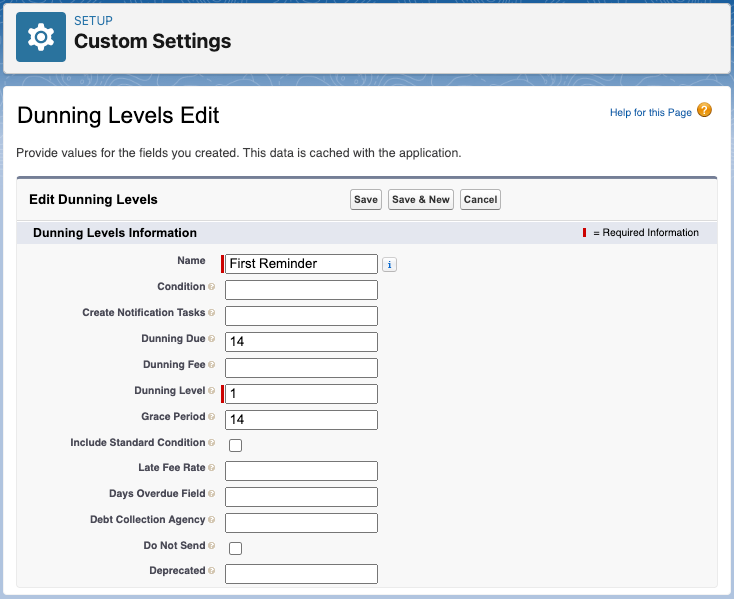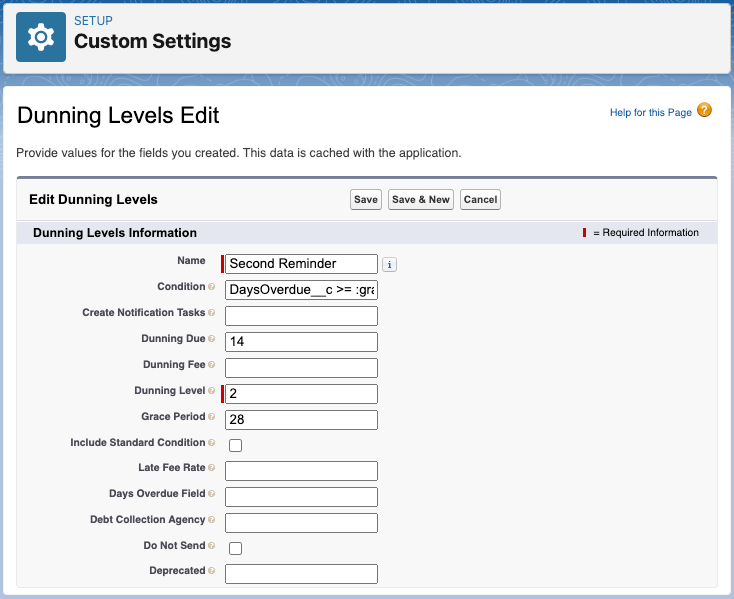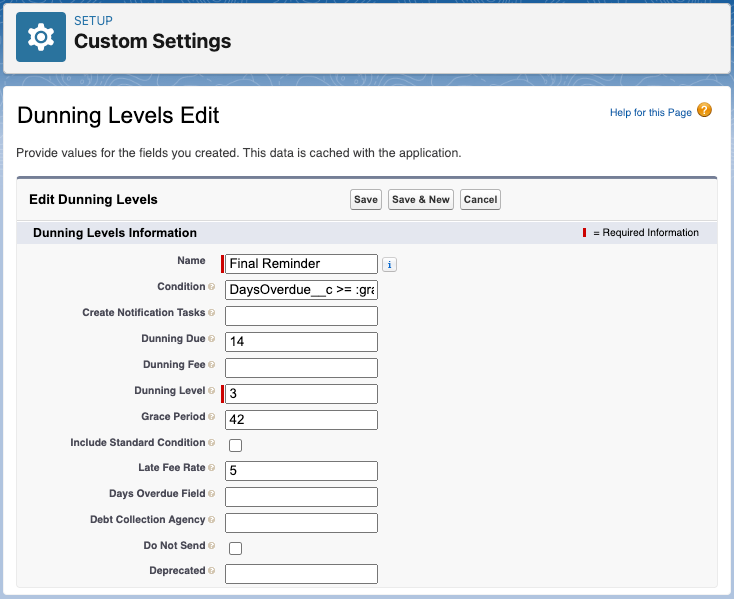Best Practice: Handling Overdue Invoices
Sometimes customers default on payments – for example, they may not pay their invoices promptly or completely. In such cases, businesses usually communicate with the customers in order to claim the receivables.
JustOn Billing & Invoice Management provides several tools that support managing outstanding payments.
Info
You enable and combine the AR collection tools you need – depending on the nature of your business, your company's or your customers' home, and, of course, the relevant jurisdiction.
Available Tools
This listing includes tools for collecting overdue receivables. To actively trigger timely payments, by contrast, you can use you can use JustOn Cash Management's bank integration or payment provider integration.
- Account statements
-
Account statements are reports that show the billings and payments of a given account for a specific time period. Businesses can use them to remind customers of sales that have not yet been paid, without expressly stating an overdue receivable and without starting a dunning process.
JustOn implements account statements using specific statements that summarize the account's balances.
- Dunning statements
-
Dunning statements officially notify customers of overdue payments. According to the overdue status, these notifications can progress from friendly reminders to firm warning letters.
JustOn implements dunning process support based on configurable dunning statements.
Using multiple dunning levels, you can build your individual dunning escalation scenario:
Invoice payment due
↳ Failure to payment: First reminder
↳ Failure to first reminder: Second reminder
↳ Failure to second reminder: Final reminder - Debt collection
-
If the dunning communication remains unfruitful, businesses may turn customers over to debt collection agencies, who usually proceed to take other collection options.
To support this option, you can specify the name of a debt collection agency when configuring your dunning levels. When set, JustOn copies the name to the invoice, where it is then available for further custom processing – for example, as a trigger to start individual value adjustments.
- Individual value adjustment
-
Individual value adjustment (or IVA) is an accounting procedure for devaluing receivables, for example, outstanding payment requests for invoices.
JustOn implements IVA for invoices using specific bookkeeping data.
- Write-off
-
Write-off is an accounting procedure for reducing or completely removing the value of an asset or receivable – for example, an uncollectible payment for an invoice.
JustOn supports writing off invoices using specific balances that count against the invoice balance.
Scenario Overview
To illustrate the options in the context of invoicing, think of the following scenario:
(1) A customer defaults on paying an invoice. You notify them of the overdue payment using account statements or (multi-level) dunning reminders.
(2) If the invoice remains unpaid and becomes more overdue, you may consider applying individual value adjustments in order to devalue the corresponding receivable.
(3) Eventually you realize that the customer is definitely not going to pay – the receivable becomes uncollectible. In this case, you must account for the loss, writing off the open amount.
(4) You may call on a debt collection agency to handle the collection. Usually, doing so also involves an individual value adjustment on your receivable.
Example AR collection scenario
Example Dunning Process Setup
Since dunning statements are a common tool for claiming outstanding payments in most countries, this article describes an example use case and outlines the corresponding configuration.
Assume the following dunning escalation scenario:
Invoice payment due
↳ Failure to payment: First reminder
↳ Failure to first reminder: Second reminder
↳ Failure to second reminder: Final reminder
(1) You set up invoices due to be paid within 14 days after their date of issue.
(2) If your customer has failed to pay within the payment due period, you issue the first reminder (a friendly reminder about the outstanding payment), setting a dunning due of 14 days.
(3) If the customer has failed to pay within the dunning due period, you issue the second reminder (a firm reminder of the overdue amount 28 days after the original invoice due), setting another dunning due of 14 days.
(4) If the customer has failed again to pay within the (new) dunning due period, you issue the final reminder (a last request to pay 42 days after the original invoice due), adding a late payment charge of 5%.
(5) You want the defined escalation and the corresponding period before issuing a higher-level reminder be respected. So even if a payment is due for more than 42 days, you want the first reminder first, then, after 14 days, the second reminder, and only after another 14 days the final reminder – and not all reminders at once.
(6) Optionally, you can allow for excluding individual accounts or individual invoices from being subject to the dunning process.
To implement this scenario, you need
- a custom formula field on the invoice to count the days after the last dunning,
- three Dunning Levels settings,
- three dunning template details.
Calculating Days Since Last Dunning
For your escalation scenario and the defined periods to be respected, you include a condition that evaluates the days since the last dunning for a particular invoice has occurred. To calculate this period, you add a custom formula field, like, for example, DaysSinceDunning, on the Invoice object:
- Navigate to the fields list of the Invoice object (
ONB2__Invoice__c). -
Create the following new field.
API Name Data Type Value DaysSinceDunning Formula (Number) TODAY() - ONB2__LastDunningDate__c
Dunning Levels Information
Following the outlined example, the required Dunning Levels settings specify the following information:
| Field | Level 1 Value | Level 2 Value | Level 3 Value |
|---|---|---|---|
| Name | First Reminder | Second Reminder | Final Reminder |
| Dunning Level | 1 | 2 | 3 |
| Grace Period | 14 | 28 | 42 |
| Dunning Due | 14 | 14 | 14 |
| Late Fee Rate | 5% | ||
| Condition | DaysOverdue__c > :gracePeriod AND DunningLevel__c = 1 AND DaysSinceDunning__c >= 14 |
DaysOverdue__c > :gracePeriod AND DunningLevel__c = 2 AND DaysSinceDunning__c >= 14 |
Info
The values of Dunning Level determine the sequence in which JustOn applies the dunning levels. Use 0 or 1 for the first dunning level to apply. Increase the value accordingly for the consecutive dunning levels.
Creating Dunning Levels Settings
You create an individual Dunning Levels record for each level of your dunning escalation scenario.
-
Click to enter Setup, then open Custom Settings.
In Salesforce Lightning, navigate to Custom Code > Custom Settings.
In Salesforce Classic, navigate to Develop > Custom Settings.
-
Click Manage in the row of Dunning Levels.
- Click New.
-
Specify the details as necessary.
The mandatory information include
NameandDunning Level.For more details, see Dunning Levels Information.
-
Click Save.
This creates the dunning level configuration, making it immediately available fo users to execute dunning runs or create individual dunning reminders.



Info
Certain circumstances may require to exclude specific accounts or specific invoices from being subject to the dunning process. For details on configuring a dunning block, see Excluding Invoices From Dunning Run.
Creating Dunning Reminders
JustOn ships a default template detail Reminder, intended to overwrite certain template fields when generating dunning reminders and printing the corresponding PDF files.
Info
You need separate dunning template details
- for each template you use for the invoice generation
- for each dunning level configuration you set up, where the name of a template detail must match the name of the corresponding dunning level setting
Use the default Reminder template detail as a model when creating your custom template details for your dunning levels.
Customizing the template details for dunning reminders according to your organization's requirements usually involves the following tasks:
Creating dunning reminder template details
You need separate dunning template details for each template you use for the invoice generation as well as for each dunning level configuration you set up.
To create a new template detail:
- Open the template to be edited.
- In the Template Details section, click New Template Detail.
-
Specify at least the template detail name and the parent template assignment.
The name must match the name of the corresponding dunning level setting.
You can edit the other information later as required.
-
Click Save.
Alternatively, you can also clone an existing template detail, for example, the default Reminder template detail. This creates a new template detail, copying the contents of the original template detail.
Configuring a dunning counter
Dunning reminders must have unique numbers to comply with legal regulations. When setting them to Closed, JustOn creates the unique and unalterable numbers for dunnings based on defined counters.
Your business may require an individual number pattern for dunning reminders, or even multiple ones for different dunning levels. In this case, you must configure the dunning counters and assign them to the corresponding template details.
-
Create dunning counters as necessary.
For details, see Counters and Number Ranges.
-
Open the relevant template detail.
- In the Information section, click
next to the
Counterfield and specify the counter to be used. - Click Save.
Note
If there are no specific dunning counters configured and assigned to the corresponding dunning template details, JustOn uses the configured invoice counter for dunning reminders.
While not illegal, using the same counter for invoices and dunning reminders is not a recommended practice.
Adjusting the statement detail table display
The Table Columns field determines the contents of the statement detail table on the printed dunning reminder. This field contains a list of statement detail fields, separated by semicolon, which determines the visible table columns and their sequence.
The default setting in the Reminder template detail is:
PosNo;Title__c;PaymentDueDate__c;DaysOverdue__c;Amount__c;LateFee__c;DunningAmount__c
This produces the following statement detail information:
- Position number
-
Statement detail title
For the statement detail type
Dunning(which refers to the actual invoices), the title is set in the template fieldDunning Title. It defaults to the original invoice number using the custom placeholder[RelatedInvoiceNo].For the statement detail type
Dunning Fee(which is produced if the applied dunning level defines a dunning fee), the title is set in the template fieldDunning Fee Title. Adjust the default value according to your needs, and provide relevant translations for your localized templates. -
Original payment due date
- Days overdue
- Open amount
- Included late fee
- Statement detail total
Depending on your organization's requirements, you must remove columns you do not need or add new columns. To do so:
- Open the relevant template detail.
- In the Information section, click
next to the
Table Columnsfield and specify the information as required. - Click Save.
Info
You can use any statement detail field. Remember that the specified order defines the column sequence.
If your business applies fix dunning fees, JustOn recommends to show the dunning fees that have accrued in previous dunning levels. To this end, add the field Previous Fees to the table configuration in templates that you use for subsequent dunning levels:
PosNo;Title__c;GrandTotal__c;Amount__c;DaysOverdue__c;PreviousFees__c;LateFee__c;DunningAmount__c
This produces the following statement detail information:
- Position number
-
Statement detail title
Defaults to the original invoice number using the custom placeholder
[RelatedInvoiceNo]. -
Original invoice total
- Open invoice amount (minus received payments)
- Days overdue
- Sum of previously accrued fixed dunning fees
- Included late fee
- Statement detail total
Modifying the text building blocks
Depending on your organization's requirements, you must modify the text building blocks for the dunning reminders. Usually, the relevant texts are included in the following fields of your dunning reminder template details:
| Field | Description | Default Value |
|---|---|---|
| Display Type | Specifies the type of the document to be printed to the PDF. | Reminder |
| Info Right | Defines an area for printing general information like a page counter and the date above the actual document text. You can use all account and dunning placeholders here. |
|
| Text 1 | Specifies the text to be rendered above the detail table, can include placeholders. | |
| Email Subject | Defines the default email subject, can include placeholders. | |
| Email Body | Defines the plain text body for the email, can include placeholders. Line breaks are considered. |
|
| PDF Name | Specifies the name pattern for the generated PDF file, can include placeholders. |
Note
Since the dunning statement can include multiple invoices (1:n relation), you must not use placeholders that relate to an individual invoice on the dunning reminder level. To name the involved invoices on the dunning reminder PDF, you include the Title column in the detail table.
To modify the texts:
- Open the relevant template detail.
-
Click next to the intended field and specify the corresponding text as required.
Alternatively, you can click Edit in the detail view to edit all fields at once.
-
Click Save.
Info
Repeat this step for each dunning level-specific template detail. Feel free to adjust the texts to the intended dunning escalation scenario.
Related information:
Managing Dunning Reminders
How to work with draft dunning reminders?
Additional Collection Features
Depending on your requirements, your use cases may involve
-
Enabling and issuing account statements instead of (or as a preliminary to) dunning statements
For details, see Setting Up Account Statement Management and Managing Account Statements.
-
Enabling and applying individual value adjustments
For details, see Configuring Individual Value Adjustment and Managing Individual Value Adjustment.
-
Writing off invoices
The manual invoice write-off does not require configuration. For details on using it, see Manually Writing Off Invoices.
